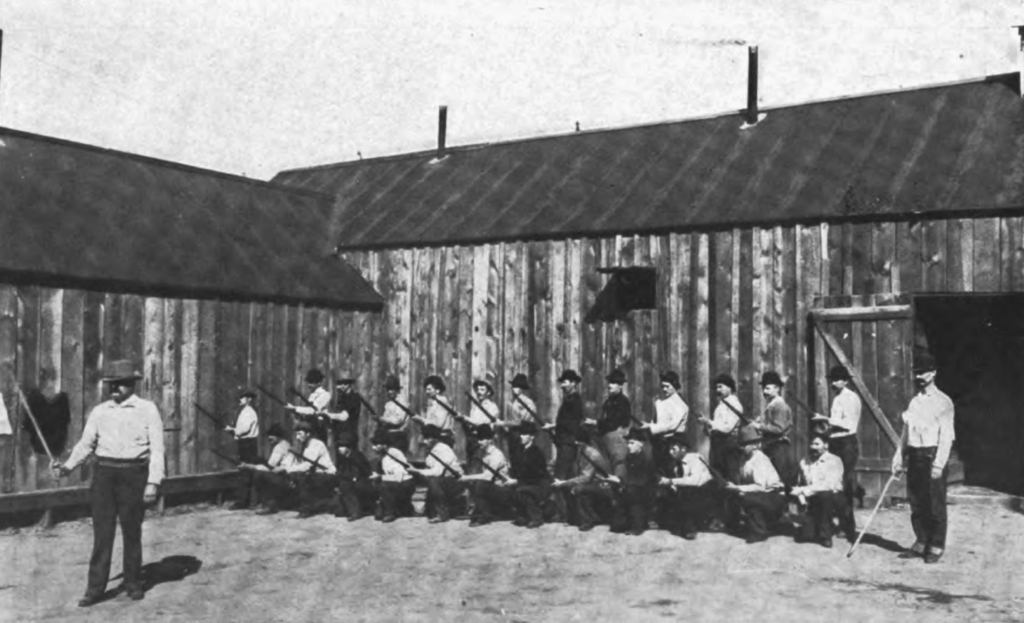This Day in Labor History: April 29, 1899

On April 29, 1899, miners in the Coeur d’Alene district of northern Idaho blew up a mine, part of the long struggle in those mines by miners for dignity against companies determined to have total control over workers. This was part of the often violent industrial warfare between workers and companies in the mining camps of the West, violence where companies held the vast majority of the responsibility.
In 1892, miners in the rich silver mines of northern Idaho went on strike. The response of owners was to hire Pinkertons to infiltrate the strike. When the miners discovered this, they went ballistic. A full-scale shooting battle began, the governor of Idaho declared martial law, and the strike was broken. In the aftermath, miners took unionism more seriously and developed the Western Federation of Miners as an industrial union of hard rock miners in the American West. It spent the rest of the 1890s flexing its muscles and even securing some key wins in Colorado.
After the 1892 strike, things in the Coeur d’Alene district did not settle down much. Tension between the mine owners and employees remained very high. The mine owners routinely hired Pinkertons to spy on workers, insinuating them into their activities and then reporting on those who talked unions. Those people would then be fired and often blacklisted from the region. The greatest villain of this would be the Bunker Hill Mining Company, a company so evil that 80 years later, they were profiled in this series for forcing women working in dangerous jobs to be sterilized in order to work, after the Civil Rights Act of 1964 barred gender discrimination at work. All the way back in 1899, it was a major employer of the Pinkertons. Bunker Hill fired 17 workers based on the Pinkerton reports.
On April 29, 250 miners stopped a train in the town of Burke, Idaho and took it over by force. They then forced the driver to take it to the town of Wardner, where the Bunker Hill Mine was. Furious, they blew it up. There was some shooting between the union miners and the non-union miners. One of each was killed. This was a $250,000 investment by Bunker Hill so they saw it as a revolutionary attack on capital. It was of course a violent attack on capital, but these miners were not really revolutionaries. They believed in their rights, they believed in wages, and they believed in their union. They would fight for all of these things and if the companies did not treat them fairly, then blowing up the mine was simply fair game. Of course the owners saw things very differently.
At this point, Idaho governor Frank Steunenberg intervened. Now, Steunenberg was a Populist. He was elected on a pro-worker agenda. But like a lot of reform politicians at this time, he was easily swayed from his supposed political principles and started siding with capital. I don’t know why Steunenberg switched so hard, but one of the insights of Robert Caro’s magical first volume of his LBJ biography is how easily these Populists, at least in Texas, were moved toward capital because lobbyists bought them steak and took them to bars and showed them the time of their life, which these quite unwealthy people had never experienced before. This was Steunenberg. Despite his words when he was elected, the mine owners got to him pretty quickly. The urged state intervention to break this strike.
Now, the state was not really going to pay for this. But the mine owners were happy to do so. While this seems to be more a rumor than a substantiated fact, it seems that Steunenberg took about $35,000 as a payment from the mine owners for his services and those of the state. How much of this he kept I don’t know. But the state used its armed forces to round up strikers and place them on trial. Most of them had committed no crime, even by the standards of the time. Many of them were eventually let free before trial. After all, the point here was to destroy the union, not lock up a lot of people at considerable state expense. But the mine companies did develop a permit system that was effectively a blacklist. In other words, not being a member of the union was a condition of employment.
For radicals, this was class war not against the mine owners, but against the miners by the companies. Radical literature explored the terrible health care in the mines, the company housing, the terrible wages, and then the use of the bullpen to jail strikers during the action. It noted that the state, the military, and the mine owners all combined in an evil monopoly of force against the working class. Job Harriman’s 1900 pamphlet is a great example of this (available on many library websites) and done with the approval of WFM leadership who appreciated the spreading of the word of how horribly they were treated by everyone from President McKinley on down to Bunker Hill owners.
In 1905, a guy named Harry Orchard bombed Frank Steunenberg’s house in Boise. By this time, Steunenberg had left the governor’s office and was living the life of a rich guy in Idaho. We still don’t really know why Orchard did this, but it got pinned on former WFM leaders Big Bill Haywood and Charles Moyer. The show trial that followed relived the violence of 1899, but it made so little sense that they would want Steunenberg killed six years later and the evidence was so shoddy that, much to everyone’s surprised, the jury found them not guilty.
This is the 438th post in this series. Previous posts are archived here.


